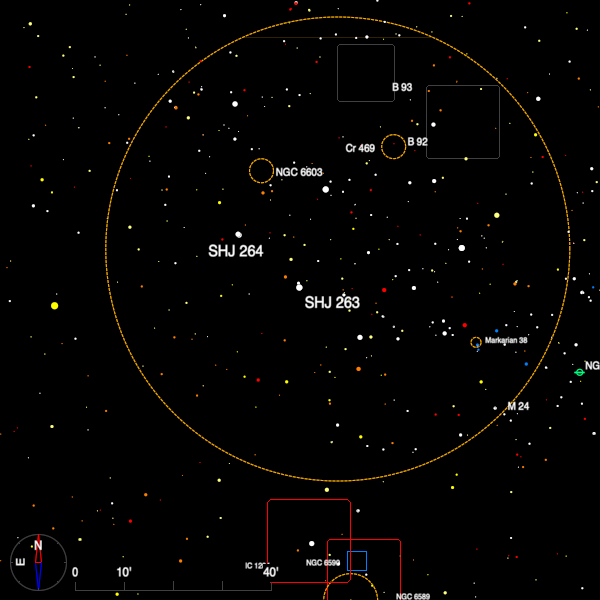May 2023 - Double Star of the Month
STF 1850 (14 28 33.239 +28 17 25.9) is a wide and fairly bright pair which can be found 3.5 degrees WNW of the spectacular pair epsilon Boötis also known as Pulcherrima - 'most beautiful' (see the column for May 2020).

The stars have changed little in relative position since they were catalogued by F. G. W. Struve and they are currently separated by 25" in PA 263 degrees. Although both are given spectral class A1V by the Washington Double Star catalog (WDS), the stars are magnitudes 7.1 and 7.6. They are rather distant, and Gaia DR3 gives the mean distance of the two as 873 light-years with an uncertainty of 1% in each case.
SHJ 263 (18 17 51.13 -18 47 54.6) sits in the yellow area marked Star Cloud M24 in The Cambridge Double Star Atlas, although it is not labelled. It is probably more accurate to define SHJ 263 as a foreground grouping of stars.
The main components are 6.8 and 9.3, separated by 54" in PA 11 degrees. The WDS lists six other companions of magnitude 12 and 13 within 30" of A and B. The only entry in Gaia DR3 for this group is that of the primary star which is given a distance of 1038 light-years whereas the distance of the star cloud as a whole is given as 10,000 light-years in the on-line literature.

Twenty minutes NE is SHJ 264 (18 18 43.26 -18 37 10.8) and the bright pair is called AC. These stars are magnitudes 6.9 and 7.6 with a separation of 17" in PA 51 degrees.
S. W. Burnham has added a couple of more difficult tests for 25-cm aperture. A is a close pair, the companion (B) is magnitude 8.2 and only 0".5 distant from A and has moved from PA 155 degrees in 1878 to a current value of 136 degrees. Some years before this, Burnham had noted a 13.1 magnitude star (D) 6" away from C whilst Philip Fox added a 10.8 at 145" from A.
The primary star is a B0Ib supergiant and Gaia DR3 gives distances of 1826 and 4672 light-years respectively for A and B.
Bob Argyle - Double Star Section Director